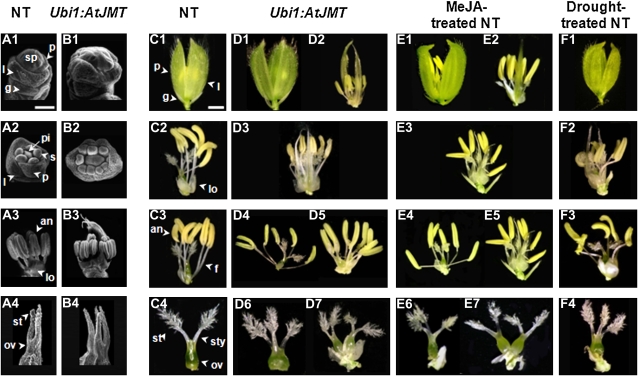Figure 4.
Spikelet morphology of NT, Ubi1:AtJMT, MeJA-treated NT, and drought-treated NT plants. Scanning electron micrographs of developing NT (A1–A4) and Ubi1:AtJMT (B1–B4) spikelets, a larger spikelet primordium (B1) than NT (A1), a spikelet with three extra stamen primordia (B2), a spikelet with extra stamens and extended lodicules (B3), and a spikelet with four stigma branches (B4). Light microscope images of NT (C1–C4), Ubi1:AtJMT (D1–D7), MeJA-treated NT (E1–E7), and drought-treated NT (F1–F4) spikelets. Ubi1:AtJMT spikelets with an extra whorl 1(D1), with lemma and palea removed showing two extra whorl 1 (D2), with normal lodicules and three extra, elongated lodicules (D3), with a stamen attached with two anthers (D4), with two extra stamens (D5), with a pistil with an extra stigma branch (D6), and with a gynoecium with an extra pistil (D7). MeJA-treated NT spikelets with an extra whorl 1 (E1), with two extra whorl 1 (E2), with extended lodicules (E3), with a stamen attached with two anthers (E4), with an extra stamen (E5), with a pistil with an extra stigma branch (E6), and with a gynoecium with an extra pistil (E7). Drought-treated NT spikelets with an extra whorl 1 (F1), with two elongated extra lodicules (F2), with an androecium with five stamens (F3), and with a pistil with an extra stigma branch (F4). an, Anther; f, filament; g, glume; l, lemma; lo, lodicule; ov, ovary; p, palea; pi, pistil; s, stamen; sp, spikelet primordium; st, stigma; sty, style. Bars = 50 μm (A1) and 1 mm (C1).

